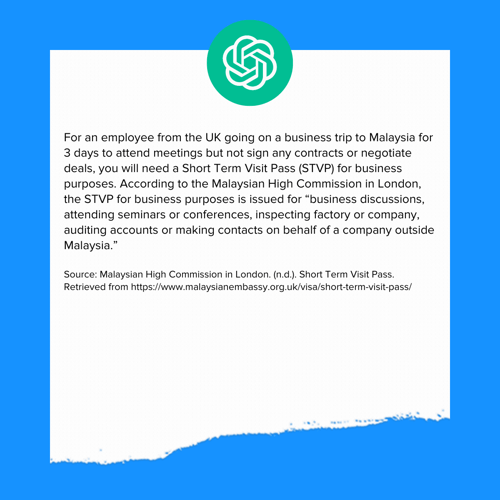.png)
Here are some simple ways for Global Mobility professionals to leverage ChatGPT on your own for your mobility program (with Use Cases to help you get started):
1. Policies
Increase knowledge and awareness of your global mobility program by efficiently creating policy documents, communications, and informative materials on the relocation process to educate employees and business partners. While the output may still need some adjustments, it allows you to become the editor rather than the writer resulting in significant time savings and clear, concise communication.
Use Case:
Your company recently approved a new benefit to your global mobility policy to provide support for pets.
Sample Prompt:
Draft an email to employees introducing pet support as part of your corporate global relocation program
Response:
.png?width=500&height=500&name=Dear%20Employees%2c%20We%20are%20thrilled%20to%20announce%20a%20new%20addition%20to%20our%20global%20relocation%20program%20that%20we%20believe%20will%20benefit%20all%20employees%20and%20their%20furry%20companions.%20Starting%20today%2c%20we%20are%20offering%20pet%20support%20as%20%20(1).png)
2. Compliance
Ensure compliance with local laws and regulations by leveraging Chat GPT’s ability to provide up-to-date information on tax and immigration laws in various locations. This can reduce the risk of legal issues and ensure the relocation process is compliant with local laws and regulations.
Use Case:
Use ChatGPT to assess a specific immigration, tax, or social security requirement that requires local expertise. While this does not replace professional advice, it can be helpful as a high-level initial assessment.
Sample Prompt:
As an employee from the UK going on a business trip to Malaysia for 3 days to do meetings but not sign any contracts or negotiate deals, which type of visa do you need? Please state the source.
Response:

Additional ways to leverage AI and GPT in your global mobility program with guidance from the Benivo team:
3. Decision-Making
Improve decision-making by using AI and GPT to provide real-time data analysis and insights to relocation teams and decision-makers, improving the quality of decision-making and enhancing overall program performance. This can help companies make more informed decisions, evaluate relocation policies to identify areas for improvement, reduce costs, and improve efficiency, ultimately resulting in a more effective and efficient relocation program.
4. Suppliers
Evaluate supplier performance with AI and GPT by monitoring and analyzing data on supplier performance, helping companies identify areas for improvement and optimize their supplier network. This can help companies reduce costs and improve efficiency by identifying the most effective suppliers and optimizing the supplier network.
5. Expense Management
Automate expense management with AI and GPT by leveraging its ability to help automate expense tracking and approval processes, reducing the workload for finance teams and improving accuracy. This can save time and resources for the company and improve the accuracy of expense tracking and reporting.
6. Communication
Streamline routine follow-up communications with AI and GPT by using it to automate routine communication tasks, such as sending reminders and updates to employees and stakeholders. This can save time for relocation teams, allowing them to focus on more important tasks, and improve the employee experience by providing regular updates and reminders.
7. Personalization
Utilize AI and GPT to analyze employee data and create personalized relocation plans and ongoing support that meet the specific needs, preferences, and budget of each employee. This can improve the overall employee experience by providing employees with a relocation plan that best meets their individual needs and providing access to personalized support throughout the relocation process.
